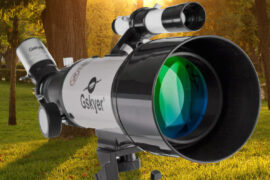A Barlow Lens is one of the most useful accessories you can get for a telescope. It has multiple uses that will give you access to magnifications and levels of detail you didn’t have before, and the best part is that it will do it at a low cost.
Even though it is a simple accessory, Barlow lenses can be a bit confusing for beginners. We have compiled some of the most common questions we have seen online and answered them to clear up any confusion.
This article is mostly for pre-purchase questions. If you are looking for specific recommendations, we already have a guide on the best Barlow lenses and if you are having trouble with a blurry Barlow lens you already own, we have a guide on how to troubleshoot and fix one.
Let’s get started.
What are Barlow lenses used for
Barlow lenses are used to increase the magnification of the images you see in your telescope by the amount of the Barlow’s divergence (1.5x, 2x, 3x, etc). They achieve this effect by decreasing the focal length of the eyepiece you connect to the Barlow. Because the formula for magnification is focal length of the telescope / focal length of the eyepiece, reducing the focal length automatically multiplies the magnification by the same amount.
But wouldn’t you get the same effect then by simply inserting an eyepiece with half the focal length?
Well, that’s exactly the problem they solve. Getting eyepieces of every size can get expensive. Instead of purchasing eyepieces of half the size of each of your current ones, you can get access to that same range of magnification levels with a single device.
A secondary use of Barlow lenses is to artificially increase the back focus of telescopes where the eyepiece slot is too close to the lens (Newtonians, usually). Barlows are almost a requirement for reflector telescopes in order to use some accessories that require ample back focus, like binocular viewers.
Are Barlow Lenses Worth It
Definitely yes!. Barlow lenses are probably the most versatile tool in any astronomer’s box. They make sense financially because they give you access to a wider range of magnification levels for little money and they can last a lifetime as long as you take good care of them. The investment is worth the cost.
Barlow lenses also make sense on the enthusiast-level because they open the possibility to explore and experiment with a lot more options, which is great for beginners as they only have a limited number of eyepieces in their collection and it helps them experiment and play with different objects at different magnitudes.
Are Barlow Lenses Universal
Barlow lenses come in the same standard diameters as eyepieces. The most common size, like in eyepieces, is 1.25″. Any 1.25″ Barlow will work with any telescope with a 1.25″ barrel. You can mix and match between brands and price ranges with no issues. If it’s 1.25″, it will fit.
Also, like eyepieces, there are a few additional sizes like 2″ and 2.5″. Those will only work with telescopes of their corresponding sizes, but again, what matters is only the diameter size. You can use any brand you want.
Can Barlow lenses be used for astrophotography
Definitely! In fact, it’s recommended for many situations because using the magnification in your camera will probably lead to poor results when taking photos.
You will need an additional T-adapter to connect the end of the Barlow lens to your DSLR. Some brands bundle them together, or they even make some adapters with a Barlow built-in.
What difference does a Barlow lens make
A Barlow lens will increase the magnification by the number promoted in its box. So, if you have a 2x Barlow lens, the difference is going to be that the image you see through the lens will have twice the magnification.
It will give you about the same image that you would get if you used an exact copy of your eyepiece, but with half the focal length.
Are there any disadvantages to Barlow lenses
The lower end, cheaper Barlows will lose a bit of brightness and your image will be slightly darker. They can also add microscopical optical aberrations, but that’s going to happen any time you add any additional piece to your optical chain.
The severity of these is going to depend on the quality of the optics inside, whether they use mirrors or prisms, and the quality assurance of the manufacturer. In the higher-end Barlows, these effects are insignificant.







